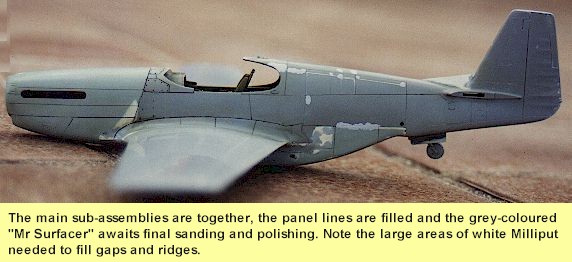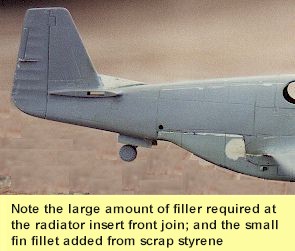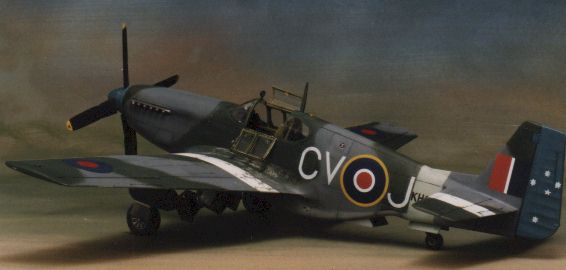|
Mustang Mk. III |
Mustangs Under the Southern Cross - Part One
3 Squadron RAAF
Building a 1/48th Scale Mustang III
by Brett Green
|
Mustang Mk. III |
Mustangs Under the Southern Cross is a four part series examining Australia's use of this thoroughbred fighter/bomber. Part One explores the RAAF's use of the Mustang III in Italy and Yugoslavia, and also describes an Australian Mustang modelling project.
Part Two continues the story of 3 Squadron RAAF, concentrating on Australia's use of the Mustang IV. Part Two also includes a construction feature on the Tamiya P-51 kit using the True Details cockpit.
Part Three will discuss Australian manufacture of the Mustang and operations in both Japan and Korea, while Part Four will provide a "walkaround" photo essay of a preserved aircraft.
| B a c k g r o u n d |
The Mustang was Australia's main strike fighter/bomber aircraft between 1944 and 1951.
These years covered three periods of front-line service - during World War Two in the
European and Pacific theatres, then in Japan as part of the Occupation Forces, and finally
in the Korean War before the delivery of more modern (but still obsolescent) Meteor jet
fighters. Back in Australia, Mustangs served with RAAF "Citizen Air Force" units
until as late as 1960.
Australia’s significant relationship with this famous aircraft included the local manufacture of Mustangs by the Commonwealth Aircraft Corporation. These were designated CA-17 Mustang Mk. 20, and CA-18 Mustangs Mk. 21-23. A total of 120 Mustangs were manufactured in Australia by CAC.
The first Australian unit to operate Mustangs was 3 Squadron. This RAAF Squadron was part of the 239th Fighter-Bomber Wing of the combined Commonwealth "Desert Air Force" since arriving in Egypt during August 1940. On 13 November 1944 3 Squadron received its first Mustang III (P-51B). Following a two day conversion course, Mustangs commenced operating alongside P-40 Kittyhawks of 450 (RAAF) Squadron. By 20 November, the last of 3 Squadron’s Kittyhawks were dispersed to other units. 3 Squadron operated a mix of Mustang III (P-51B/C) and Mustang IV (P51-D/F) until May, 1945.
Despite bad weather during the winter of 1944/45, 3 Squadron Mustangs were responsible for the destruction of many locomotives, at least three key bridges and other items of German equipment. They also flew many operations against retreating German troops including the use of Napalm from January 1945.
Although Luftwaffe activity was relatively rare at this stage, 3 Squadron lost one Mustang to a Bf109 in December 1944. Four more were lost to ground fire and a number of Mustangs were also lost in bad weather.
A number of successful RAAF pilots posted to RAF Squadrons also flew Mustangs. The most notable was Flying Officer John Haslope, attached to 165 Squadron RAF. In a Mustang III, FO Haslope shot down a rocket-powered Messerschmitt Me 163 Komet on 10 April 1945.
| B u i l d i n g a n R A A F M u s t a n g I I I |
The Choice
When I built this model in mid-1995 the only out-of-the-box choice for building a P-51B/C in 1/48 scale was Monogram’s kit. This was a nice model, but betrayed its 1970’s origins by oversimplified detail and raised panel lines.
I decided to use Aeromaster’s P-51B conversion (Item #608) on the Accurate Miniatures P-51A Mustang (Kit No. 3402). This was one of the first batch of Accurate Miniatures releases. It featured fine detail including an excellent cockpit and superb engraved panel lines. Options in the kit were limited to the choice of either round or flattened tyres (the first mainstream manufacturer to offer this option), drop tanks and a clear-vision Malcolm Hood as an alternative to the framed canopy. All of these options were equally relevant to the later Mustang III.
The Aeromaster conversion supplies a new resin nose, radiator scoop (including a chunk of lower fuselage), spinner, exhaust stacks and 4 x white metal Hamilton-Standard propeller blades. Aeromaster’s instructions describe the conversion as being "so easy that only three cuts need to be made". Unfortunately this is not the case. There are considerably more than three cuts. There is also some scratch-building plus extensive re-scribing required; and the fit of the major components is challenging to say the least. The conversion also fails to address the subtle plan-form differences in the shape of the forward wing-root on the later aircraft. Nevertheless, the quality of the resin castings is first rate, and the surface detail is every bit as crisp as the excellent AM donor kit.
Construction
The first task required is to trim some plastic from the nose of the AM kit, while leaving in place a thin strip of wing root under the engine cowling. A section of fuselage must also be removed. I made sure to cut away less plastic than I thought necessary, then continually dry-fitted to minimise filling later.
 The kit cockpit was assembled and
painted according to AM's kit instructions. The supplied detail was so good that the only
detail I added was a "Reheat" Sutton Harness. The rear fuselage halves were
joined and the wings completed.
The kit cockpit was assembled and
painted according to AM's kit instructions. The supplied detail was so good that the only
detail I added was a "Reheat" Sutton Harness. The rear fuselage halves were
joined and the wings completed.
The resin nose and radiator-scoop insert were then dry-fitted to the plastic fuselage. There were some gaps at the fuselage join of the radiator insert, and big steps between all resin parts and the plastic donor parts. The resin parts were glued in place and Milliput was used to correct the gaps and fill the steps. I also filled the panel lines on the rear fuselage with Milliput. These would later be re-scribed to represent the correct lines of the Mustang III.
 The completed wing assembly was then
dry-fitted. Although the instructions did not mention it, a section of the mid-rear of the
kit lower wing had to be removed to allow the larger radiator to fit. Following this
surgery the wing was glued in place. Milliput was required to fill the resulting gaps.
When these components were thoroughly set, the Milliput was sanded prior to a final
application of Gunze "Mr Surfacer". I often use this Gunze product to ensure
that no gaps or seams are visible. When the "Mr Surfacer" was dry, it was sanded
with a fine sanding stick and polished. Following this treatment, the correct panel lines
were scribed with my Tamiya Scribing Tool, using Dymo tape as a guide.
The completed wing assembly was then
dry-fitted. Although the instructions did not mention it, a section of the mid-rear of the
kit lower wing had to be removed to allow the larger radiator to fit. Following this
surgery the wing was glued in place. Milliput was required to fill the resulting gaps.
When these components were thoroughly set, the Milliput was sanded prior to a final
application of Gunze "Mr Surfacer". I often use this Gunze product to ensure
that no gaps or seams are visible. When the "Mr Surfacer" was dry, it was sanded
with a fine sanding stick and polished. Following this treatment, the correct panel lines
were scribed with my Tamiya Scribing Tool, using Dymo tape as a guide.
At this stage I fabricated a fin fillet and two radiator doors from polystyrene sheet. These were added to the model at the same time as the exhaust stacks. The new props and spinner were assembled and set aside for painting later.
The rest of the kit was completed according to
the kit instructions with a only few additional details. The open kit canopy was detailed
with brass and styrene, a rear vision mirror was added, bombs were rescued from a Hasegawa
Mustang kit and fixed to the AM mounts and antenna wire was glued in place.
Painting and Decals
 3 Squadron (RAAF) Mustangs in the
winter of 1944/45 were more colourful than most of their rather predictable RAF
contemporaries.
3 Squadron (RAAF) Mustangs in the
winter of 1944/45 were more colourful than most of their rather predictable RAF
contemporaries.
Spinners were painted in Flight colours of either red or blue, the wings and horizontal stabilisers featured width-wise white ID stripes and the rudders were painted a medium blue colour and adorned with the five stars of the Southern Cross. Combined with the standard theatre markings of yellow wing leading edge stripes and sky fuselage bands, these aircraft were almost garish.
This model represents a Mustang III on charge with 3 Squadron RAAF when based at Fano, Italy late in 1944.
I first sprayed a base coat of Tamiya Flat Black along panel lines before spraying White and Sky over the approximate areas to be covered by the ID lines and the fuselage band. I then masked off these features and sprayed the Medium Grey colour on the lower surfaces. The fuselage camouflage lower demarcation line was masked with Tamiya tape, and the upper colours (Ocean Grey and Dark Green) were sprayed in a freehand pattern. Tamiya Acrylics were used for all colours.
The spinner was first painted Tamiya Chrome Silver enamel then, when dry, sprayed with a medium blue mix. This mix was also applied to the rudder. Paint was chipped off the spinner to duplicate the heavy weathering seen on a photograph of the subject aircraft.
Decals were sourced from "Aussie Decals" sheet number A48003. This interesting sheet provides markings for four 3 Squadron Mustangs, including a Mk. IV in natural metal. These decals were very thin and transparent, but tended to curl-up on themselves - particularly the stars of the Southern Cross. However, with a generous application of wetting solution they sucked down onto the model nicely!
A thin mix of murky black-brown was sprayed along
both fuselage sides to represent light exhaust staining. Further chipping and scuffing was
added by applying Tamiya Chrome Silver with a fine brush before a final coat of Gunze Flat
Clear acrylic.
| C o n c l u s i o n |
There is no need for anyone but a masochist to go to these lengths to build an accurate
and detailed Mustang III today.
A modeller approaching the same project would now
be faced with a different dilemma - which of the three state-of-the-art P-51B/C kits is
best? In my opinion, its a toss-up between the Accurate Miniatures P-51B/C kits which wins
in the "detail" department and the Tamiya P-51B which wins in the "best
fit" and "ease of assembly" departments.
| R e f e r e n c e s |
The Modeller's Guide to the RAAF Mustang by
Gary Byk, Red Roo Models Publications, Melbourne, 1996
ISBN Unknown - limited publication of 500 copies still available
from the Publisher
The Spitfire, Mustang and Kittyhawk in
Australian Service by Stewart Wilson, Aerospace Publications Pty Limited, Sydney, 1988
ISBN 0 9587978 11
Mustangs of the RAAF and RNZAF by Peter
Anderson, AH and AW Reed Pty Ltd., Sydney, 1975
ISBN 0 589 07130 0
IPMS News and Views (IPMS NSW Magazine) 3/1988 "Fighter Squadrons of the RAAF in WWII Part 6 - 3 Squadron P40Ns and P51s" by Steve McKenzie, Sydney, 1988
P-51 Mustang in Action by Larry Davis,
Squadron Signal Publications, Carrollton, Texas, 1981
Go to Part Two of Mustangs Under the Southern Cross - "3 Squadron Mustang IVs in Italy"
Back to HyperScale Main Page
Back to Features Page